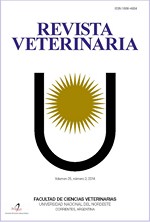Comparación del test directo de anticuerpos fluorescentes y el cultivo bacteriológico para detección de Brucella suis
DOI:
https://doi.org/10.30972/vet.3013896Palabras clave:
Cerdo, Brucella sp, fluoresceína anti-Brucella globulina, impronta, sensibilidad, especificidadResumen
El diagnóstico de brucelosis se apoya en el cultivo bacteriológico o en la detección de fragmentos de ADN de la bacteria mediante la reacción en cadena de la polimerasa. El empleo de una inmunoglobulina anti-Brucella conjugada a fluoresceína para la detección de este antígeno en tejidos constituye una técnica simple, fácil, reproducible, económica y rápida. El objetivo de este trabajo fue evaluar la fracción gammaglobulínica de un suero policlonal anti-Brucella abortus marcada con isotiocianato de fluoresceína (FITC), 1) contra distintas especies lisas y rugosas de Brucella sp, 2) contra bacterias de otros géneros, y 3) comparar los resultados obtenidos con la inmunofluorescencia directa y el cultivo bacteriológico para la detección de B. suis en distintos tejidos de porcinos infectados. Este conjugado detectó todas las brucelas con distinta intensidad de fluorescencia, pero no hubo fluorescencia inespecífica cuando se ensayaron las bacterias de otros géneros. La fluorescencia de fondo en muestras de los distintos tejidos infectados fue baja. La mayoría de los tejidos infectados mostraron la presencia de microorganismos verde-fluorescentes con la morfología de las brucelas. El anticuerpo conjugado a FITC permitió un diagnóstico de brucelosis rápido, efectivo y económico.
Descargas
Descargas
Publicado
Cómo citar
Número
Sección
Licencia
Derechos de autor 2019 S M. Estein, A R. Bence, C S. Cacciato, H M. Echavarría, P Soto

Esta obra está bajo una licencia internacional Creative Commons Atribución-NoComercial 4.0.
Política de acceso abierto
Esta revista proporciona un acceso abierto inmediato a su contenido, basado en el principio de que ofrecer al público un acceso libre a las investigaciones ayuda a un mayor intercambio global de conocimiento. La publicación por parte de terceros será autorizada por Revista Veterinaria toda vez que se la reconozca debidamente y en forma explícita como lugar de publicación del original.
Esta obra está bajo una licencia de Creative Commons Reconocimiento-NoComercial 4.0 Internacional (CC BY-NC 4.0)










.jpg)
.jpg)



